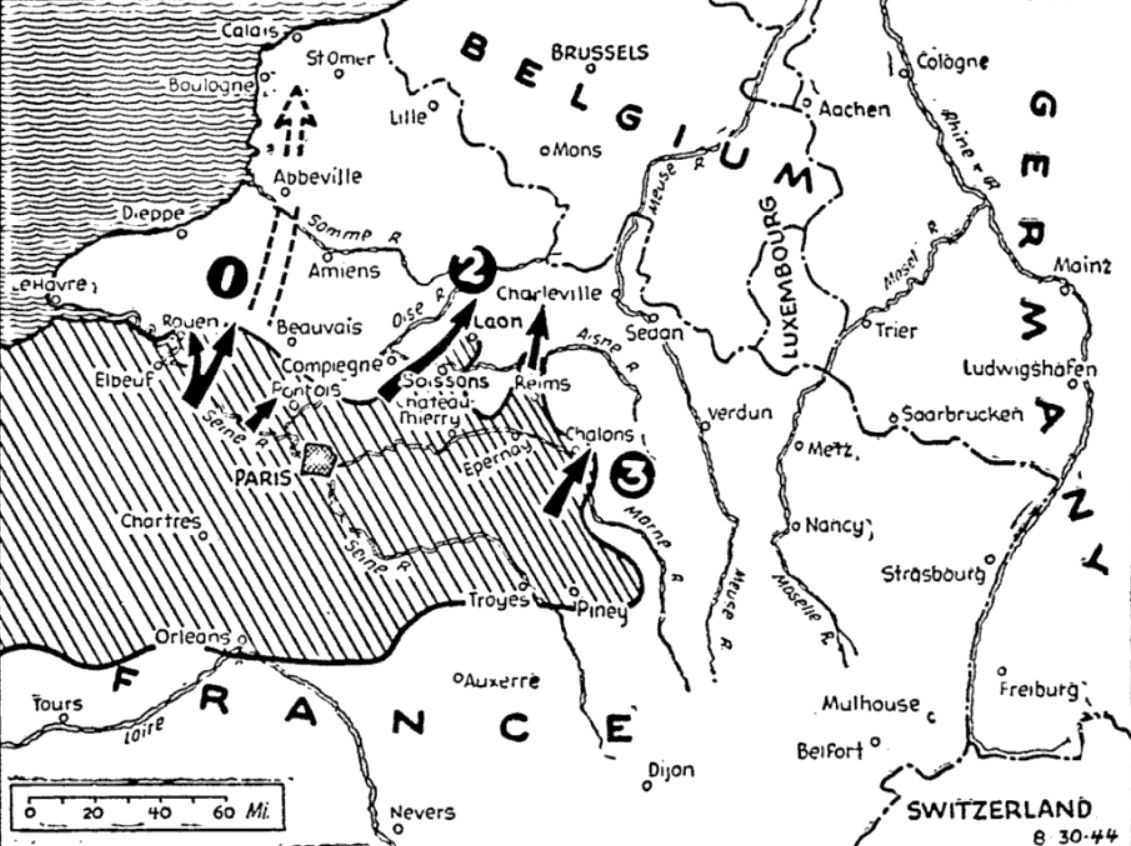Innsbrucker Nachrichten (August 30, 1944)
Feindkräfte zwischen Paris und Reims aufgefangen
Schwere Kämpfe um Châlons-sur-Marne – Briançon zurückerobert – Sowjetangriffe in harten Panzerkämpfen abgewehrt
dnb. Aus dem Führerhauptquartier, 30. August –
Das Oberkommando der Wehrmacht gibt bekannt:
Nachdem unsere Divisionen starke, bis zu siebenmal wiederholten Angriffen des Feindes aus seinen Seine-Brückenköpfen nordwestlich Paris in harten Kämpfen aufgefangen hatten, setzten sie sich befehlsgemäß auf neue Stellungen nach Nordosten ab. Die Stadt Rouen wurde nach Zerstörung der Hafenanlagen und sonstiger militärisch wichtiger Objekte aufgegeben.
Zwischen Paris und Reims wurden die nach Norden angreifenden starken nordamerikanischen Kräfte in erbitterten Kämpfen zum Stehen gebracht. Im Südteil von Soissons sind heftige Straßenkämpfe entbrannt. Südlich der Marne erreichten motorisierte feindliche Verbände im Vorstoß nach Osten die Gegend von Châlons-sur-Marne, um das schwer gekämpft wird.
Im Rhonetal wiesen unsere Flankensicherungen zahlreiche feindliche Angriffe von Osten her ab. Eine größere Anzahl feindlicher Panzer wurde vernichtet. Im Alpengebiet westlich der französisch-italienischen Grenze wurde die Stadt Briançon nach hartem Kampf mit französischen Terroristen und amerikanischen Aufklärungskräften wieder in Besitz genommen.
Schnellboote versenkten in der Nacht zum 30. August westlich Dieppe einen feindlichen Zerstörer. Im gleichen Seegebiet vernichteten Kampffähren und Sicherungsfahrzeuge der Kriegsmarine einen britischen Zerstörer der Hunt-Klasse, der nach schwerer Detonation auseinanderbrach.
Das „V1“-Vergeltungsfeuer auf London dauert an.
In Italien fanden größere Kampfhandlungen nur im adriatischen Küstenabschnitt statt. In den Vormittagsstunden wurden hier heftige Angriffe des Gegners verlustreich für ihn abgewiesen.
In Rumänien scheiterten Angriffe der Sowjets bei Buzau und im Bistrizatal. Die dazwischen über die Pässe des ungarischen Grenzgebietes vorgedrungenen feindlichen Kräfte wurden an mehreren Stellen im Gegenangriff zurückgeworfen. Schlachtfliegerverbände griffen sowjetische Kolonnen auf den Karpatenpässen mit Bomben und Bordwaffen erfolgreich an.
Im Weichselbrückenkopf westlich Baranow blieben wiederholte Angriffe der Bolschewisten erfolglos.
Nordöstlich Warschau sowie zwischen Bug und Narew fingen unsere Truppen erneute von Panzern und Schlachtfliegern unterstützte Angriffe der Sowjets in harten Panzerkämpfen auf.
Im Nordabschnitt brachen mehrere Angriffe des Feindes westlich Modohn und nordwestlich Dorpat verlustreich zusammen. In der Nacht waren Truppenansammlungen und Bereitstellungen der Sowjets in den Räumen von Modohn und Dorpat Angriffsziele unserer Kampf- und Nachtschlachtflieger.
Nordamerikanische Bomber griffen die Städte Mährisch-Ostrau und Oderberg sowie ungarisches Gebiet an. In der Nacht führte die britische Luftwaffe erneut unter Verletzung schwedischen Hoheitsgebietes Terrorangriffe gegen Stettin und Königsberg. Einzelne feindliche Flugzeuge warfen außerdem Bomben auf Berlin und Hamburg. Luftverteidigungskräfte schossen bei diesen Angriffen 82 viermotorige Terrorbomber ab.
Ergänzend zum heutigen OKW-Bericht wird gemeldet:
Zwischen Bug und Narew haben sich eine Kampfgruppe der 7. Infanteriedivision unter der Führung von Oberst Weber und die Schwere Panzerabteilung 507 unter Führung des Ritterkreuzträgers Major Schmidt durch unerschütterliche Standfestigkeit und schneidig geführte Gegenstöße besonders ausgezeichnet.
Eine Jagdgruppe unter Führung von Hauptmann Lang schoss in Westfrankreich seit Invasionsbeginn 100 feindliche Flugzeuge ab und zeichnete sich auch bei Tiefangriffen gegen den Feind besonders aus.
In der Bretagne hat eine vom Feind eingeschlossene Stützpunktbesatzung der Luftnachrichtentruppe unter Führung von Oberleutnant Sasse wochenlang schwersten Angriffen weit überlegener Kräfte in heldenhaftem Kampf standgehalten und die viermalige Aufforderung zur Übergabe abgelehnt.




